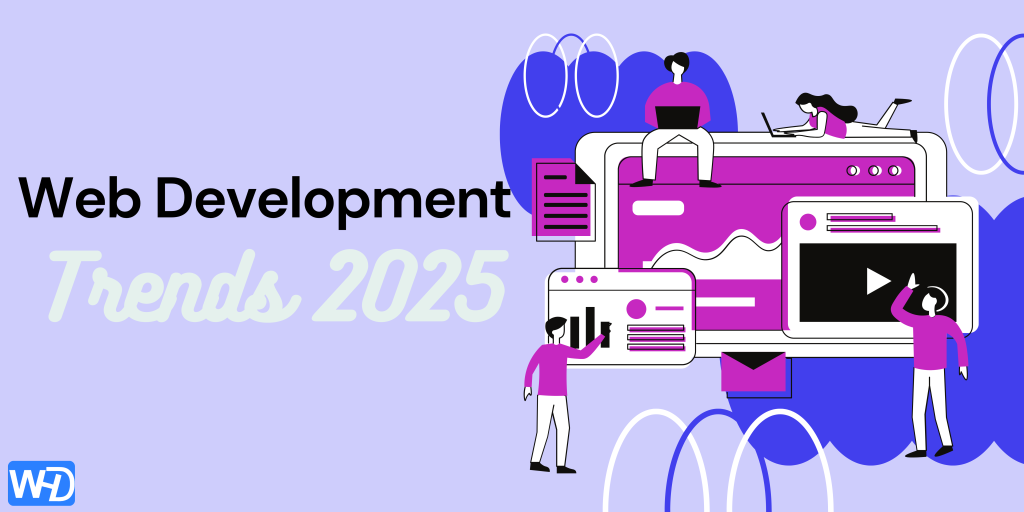As we step into 2025, the web development field is evolving rapidly. The business trends continue transforming from offline to digital platforms. The internet is no longer just about static websites; instead, it’s an ecosystem of immersive experiences, AI-powered interactions, and highly dynamic applications.

Whether you’re an entrepreneur or business owner, understanding these trends is crucial to remain competitive. Let’s explore the top web development trends that will dominate in 2025.
1. Progressive Web Apps (PWAs) Continue to Rise
PWAs have been gaining momentum for a while now, and in 2025, their adoption will only increase. These applications offer a seamless experience similar to native apps but run directly through the web browser. They come with benefits such as faster loading times, offline functionality, and improved SEO rankings. With mobile-first strategies becoming essential, PWAs will be a game-changer for businesses aiming for high engagement and retention.
Why it matters:
- Works offline, providing uninterrupted access.
- Enhances user experience with app-like functionality.
- Improves performance and reduces bounce rates.
2. Single Page Applications (SPAs) for Faster Interactions
SPAs enable a smooth and fast user experience by loading content dynamically without requiring full-page reloads. They are particularly beneficial for eCommerce platforms, social networks, and SaaS applications.
Why it matters:
- Faster loading speeds improve user satisfaction.
- Enhanced interactivity leads to better engagement.
- Ideal for businesses focusing on real-time updates and dynamic content.
3. AI-Powered Web Experiences
Artificial Intelligence (AI) and Machine Learning (ML) are revolutionizing web applications by making them smarter and more intuitive. From AI-driven chatbots to personalized content recommendations, AI is enhancing user interactions like never before.
Why it matters:
- Enables predictive analysis for better customer insights.
- AI chatbots enhance customer service and engagement.
- Automates web development tasks, improving efficiency.
4. Voice Search Optimization
With the growing popularity of virtual assistants like Siri, Alexa, and Google Assistant, voice search is set to reshape how users interact with websites. Optimizing content for voice search can boost visibility and organic reach.
Why it matters:
- More than 50% of online searches are now voice-based.
- Enhances accessibility and user convenience.
- Helps businesses capture a growing segment of voice search users.
5. Micro Frontend Architecture
Micro Frontend is a trend that allows developers to break down frontend applications into smaller, manageable components. This makes development more scalable, flexible, and efficient, especially for large enterprises with multiple teams working on different parts of a project.
Why it matters:
- Speeds up development and deployment.
- Improves code maintainability.
- Enhances scalability, making it easier to introduce new features.
6. Accelerated Mobile Pages (AMP) for Better Performance
Google’s AMP technology enables websites to load almost instantly on mobile devices, reducing bounce rates and improving engagement.
Why it matters:
- Enhances mobile user experience.
- Improves SEO and search rankings.
- Reduces data consumption, making browsing faster.
7. API-First Development for Seamless Integration
In an interconnected digital world, APIs play a crucial role in ensuring seamless communication between different platforms. API-first development ensures that APIs are built before the frontend, allowing for better scalability and cross-platform compatibility.
Why it matters:
- Streamlines cross-platform development.
- Reduces development time and costs.
- Enhances system flexibility and future scalability.
8. Retro Futurism in Web Design
Retro Futurism combines nostalgic design elements with futuristic aesthetics, making websites visually striking and memorable. This trend is gaining popularity as brands seek to differentiate themselves with unique and engaging designs.
Why it matters:
- Creates an emotional connection with users.
- Enhances brand identity and recognition.
- Encourages user engagement through visually captivating elements.
9. Motion UI for Engaging User Interfaces
Motion UI enhances the user experience by adding animations and interactive elements to websites. From smooth transitions to dynamic page effects, this trend makes web applications more engaging and visually appealing.
Why it matters:
- Captures users’ attention and improves retention.
- Enhances storytelling through visual elements.
- Makes interactions more intuitive and enjoyable.
10. Cybersecurity as a Priority
With the rise in cyber threats, businesses are investing in stronger security measures to protect user data and prevent breaches. Multi-factor authentication (MFA), end-to-end encryption, and blockchain-based security solutions are becoming more prevalent.
Why it matters:
- Protects sensitive user data.
- Reduces the risk of cyberattacks.
- Builds trust and credibility with users.
Final Thoughts: Staying Ahead in 2025
The future of web development is all about enhancing user experience, improving performance, and ensuring security. Businesses that embrace these trends will stand out in an increasingly competitive digital landscape.
Whether you’re building a new website or upgrading an existing one, incorporating these advancements can help you stay ahead of the curve. Investing in cutting-edge technologies and collaborating with expert developers will be key to future-proofing your digital presence.